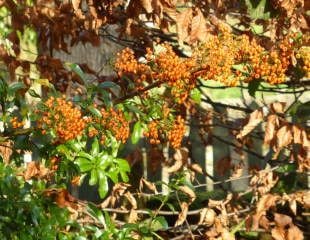
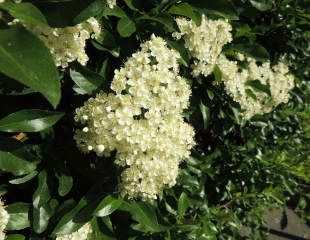
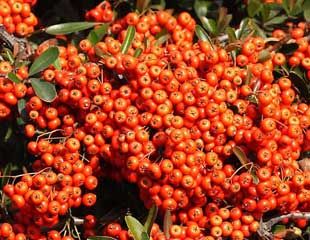
How to grow Pyracantha common name Firethorn

Pyracantha is an evergreen, small to medium-sized shrub. In the spring it has white flowers, which are attractive to pollinators followed by brightly coloured berries, red, yellow or orange, depending on the variety. Its common name is Firethorn on account of the coloured berries. This image does not do Pyracantha justice, as the berries really are very bright and make an impressive display.
Pyracantha is an excellent supporter of wildlife. The white flowers in the spring are attractive to pollinators, the berries provide food for birds in the autumn, and the shrub provides nesting sites.
Pyracantha has a medium rate of growth, and can be wall-trained, standalone, form part of a shrub border, or for hedging (see below.) If you want to wall train Pyracantha, it makes an excellent display on the front of a house. Tie in new shoots to fan outwards and prune off any outward facing growth to keep it growing flat on the wall.
Generally, Pyracantha requires very little routine pruning except to remove crossing, dead or congested growth or to prune down.
Plant Pyracantha in full sun or partial shade. Some varieties are more hardy than others so if you are planting in a colder area select a variety which is fully hardy such as P. Orange glow (illustrated top left), or P. coccinea, 'Golden Charmer' or Golden Dome or check with your supplier.
Pyracantha can suffer from pyracantha scab, and fireblight. There are new varieties of Pyracantha which are resistant to these diseases such as P. Golden Charmer and the Saphyr series.
As with all newly planted shrubs, remember, water, water, and water.
Pyracantha Scab

Pyracantha is a tough, grow anywhere shrub, but occasionally it can get infested with Scab or fire blight.
Scab is a fungal disease which attacks leaves and berries, causing leaves to drop off and malformed berries. Unfortunately, scab has affected the mature Pyracantha in the image on the left.
If Scab strikes,remove all infested leaves, and any in the soil as Scab can over winter. As gardeners, we try to avoid pesticides, but it is hard to get rid of scab without using a commercial spray.
There are new varieties of Pyracantha which are resistant to these diseases which are the Saphyr series. Pyracantha Saphyr Rouge ('Cadrou') with red berries, Pyracantha Saphyr Jaune ('Cadaune') with Yellow berries and Pyracantha Saphyr Orange ('Cadange') orange berries are all well worth considering if you look how badly Scab can affect a pyracantha shrub.
Disease resistant Pyracantha are on sale at Crocus, and Suttons have 7 other popular varieties of Pyracantha on sale (affiliate links)
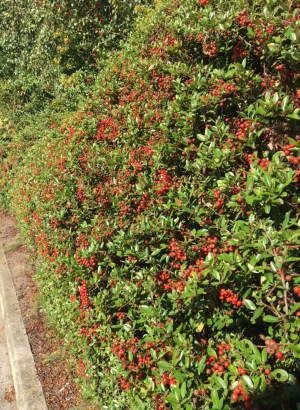
Pyracantha is a tough shrub
One advantage of growing Pyracantha is that it is a tough shrub tolerant of shade, including being grown on a north-facing wall. In shady conditions there may be fewer flowers and berries, but it will grow well. Pyracantha is tolerant of all soil types except waterlogged ground and is low maintenance, requiring little attention once established.
If you are intending to wall train Pyracantha, avoid the rain shadow aspect of the wall.
The images do not really do justice to the shrub as the berries provide a lot of autumn colour and look striking. They are also attractive to birds, making Pyracantha a good wildlife shrub.
How to Prune Pyracantha
For the first three or four years, as the shrub is getting established, no pruning is required, except a light trim if some stems are wayward. Pruning Pyracantha routinely is unnecessary, but if pruning is needed, timing is important.
Pruning in the wrong way, or at the wrong time, may cause a lack of flowers or berries. Pyracantha flowers on old wood, that is last year's branches and those same branches carry this year's fruit. This is important. Wait until the shrub is in flower, pick those stems which are not bearing any flowers and prune away any diseased, spindly, older stems by about a third. This will keep the plant in shape and retain the flowers and later berries. Prune only the non flowering stems.
The more you prune back the previous years' growth and older wood, the more you risk the flowers and berries. If the shrub needs renovating, or has become leggy, you can cut it back by fairly hard, up to half. It will survive, but the flowers and berries will be scant that year and return the following year. When pruning watch out for the thorns, thick gloves are necessary.
Compare similar shrubs: Pyracantha v Berberis
Pyracantha
'Orange glow'
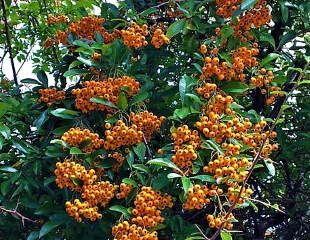
Pyracantha is evergreen, with small oval shaped shiny green leaves. Its flowers are always white, followed by berries in the autumn.
In common with Berberis, Pyracantha has thorny with sharp spines. Both are excellent in a shrub border and thorns can be a deterrent.
Berberis darwinii in flower
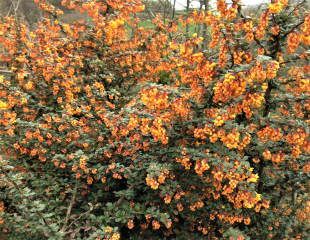
Berberis shrubs can be evergreen or deciduous. Illustrated B.'Orange glow' is evergreen and at first glance looks a little like a Pyracantha.
A closer look will show that the leaves to be a spine tooth shape, and the orange is the flowers. In common with Pyracantha, Berberis produce berries in autumn, usually red.
